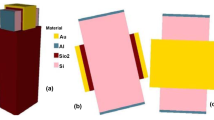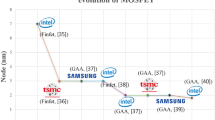Abstract
Grooved gate structure Metal-Oxide-Semiconductor (MOS) device is considered as the most promising candidate used in deep and super-deep sub-micron region, for it can suppress hot carrier effect and short channel effect deeply. Based on the hydrodynamic energy transport model, using two-dimensional device simulator Medici, the relation between structure parameters and hot carrier effect immunity for deep-sub-micron N-channel MOSFET’s is studied and compared with that of counterpart conventional planar device in this paper. The examined structure parameters include negative junction depth, concave corner and effective channel length. Simulation results show that grooved gate device can suppress hot carrier effect deeply even in deep sub-micron region. The studies also indicate that hot carrier effect is strongly influenced by the concave corner and channel length for grooved gate device. With the increase of concave corner, the hot carrier effect in grooved gate MOSFET decreases sharply, and with the reducing of effective channel length, the hot carrier effect becomes large.
Similar content being viewed by others
References
C. Hu, Simulating hot-carrier effects on circuit performance, Semicon. Sci. Technol, 7(1992)3B, B555-B558.
C. Fiegna, H. Iwai, T. Wada, M. Saito, E. Sangiorgi, B. Ricco, Scaling the MOS transistor below 0.1 µm: Methodology, device structures, and technology requirements, IEEE Trans. on Electron Devices, 41(1994)6, 941–951.
C. Hu, S. Tam, F. C. Hsu, P. K. Ko, T. Y. Chan, K. W. Terrill, Hot-electron-induced MOSFET degradation model, monitor and improvement, IEEE Trans. on Electron Devices, 32(1985)2, 375–385.
Technology Modeling Associates, Inc. Medici Two-Dimensional Device Simulation Program Version 2.3 User’s Manual, Vol.1, Feb 1997.
S. Tam, P. Ko, C. Hu, Luck-electron model of channel hot-electron injection in MOSFETs, IEEE Trans. on Electron Devices, 31(1984)9, 1116–1125.
Technology Modeling Associates, Inc., TSUPREM4 Version 6.5 User’s Manual, May 1997.
P. H. Bricout, E. Dubois, Short-channel effect immunity and current capability of sub-0.1-micron MOSFET’s using a recessed channel, IEEE Trans. on Electron Devices, 43(1996)8, 1251–1255
Author information
Authors and Affiliations
Additional information
Supported by the National Defense Preresearch Fund Program (No.99J8.1.1.DZD132)
About this article
Cite this article
Ren, H., Zhang, X., Hao, Y. et al. Study on the relation between structure and hot carrier effect immunity for deep sub-micron grooved gate NMOSFET’S. J. of Electron.(China) 20, 202–208 (2003). https://doi.org/10.1007/BF02687705
Received:
Revised:
Issue Date:
DOI: https://doi.org/10.1007/BF02687705




